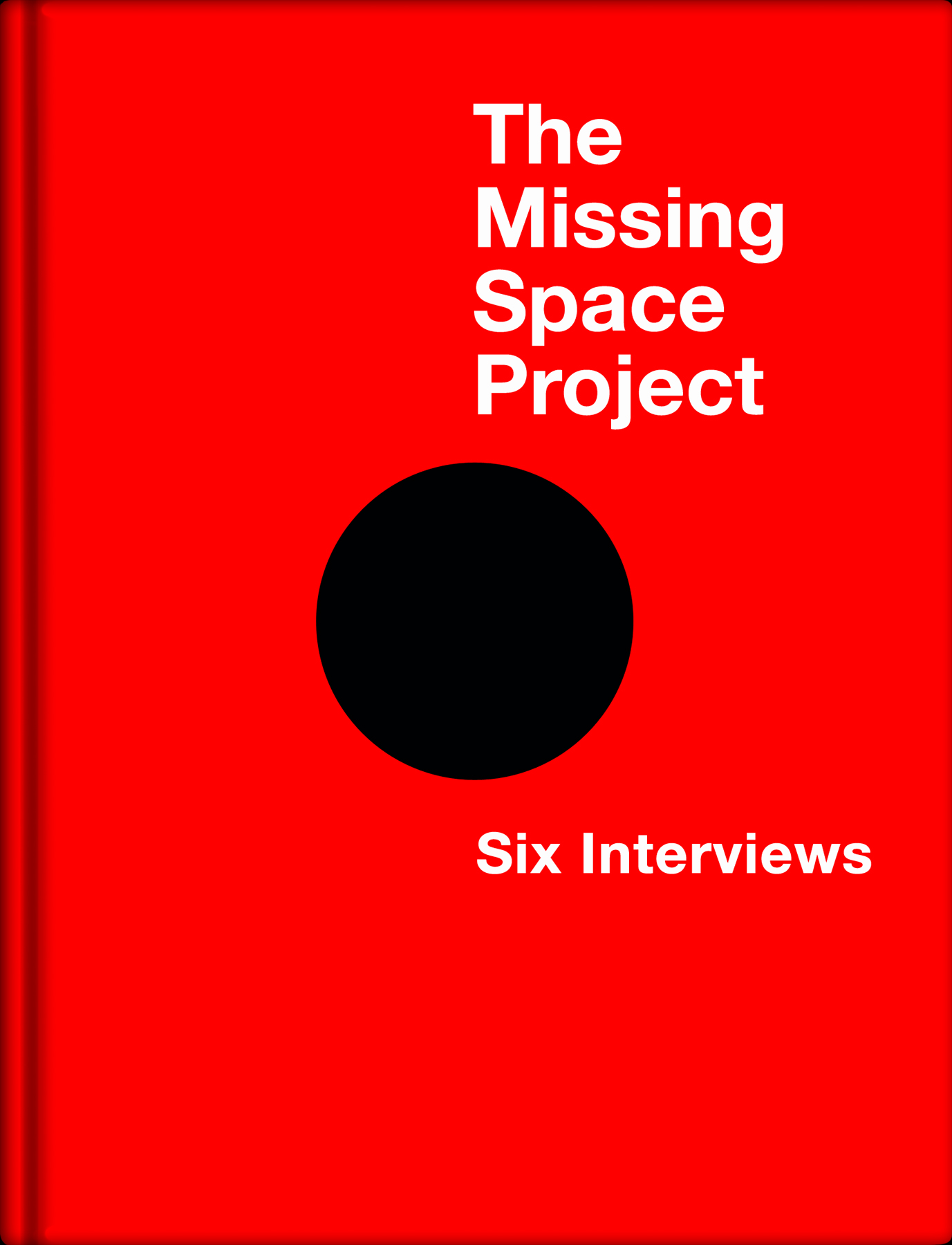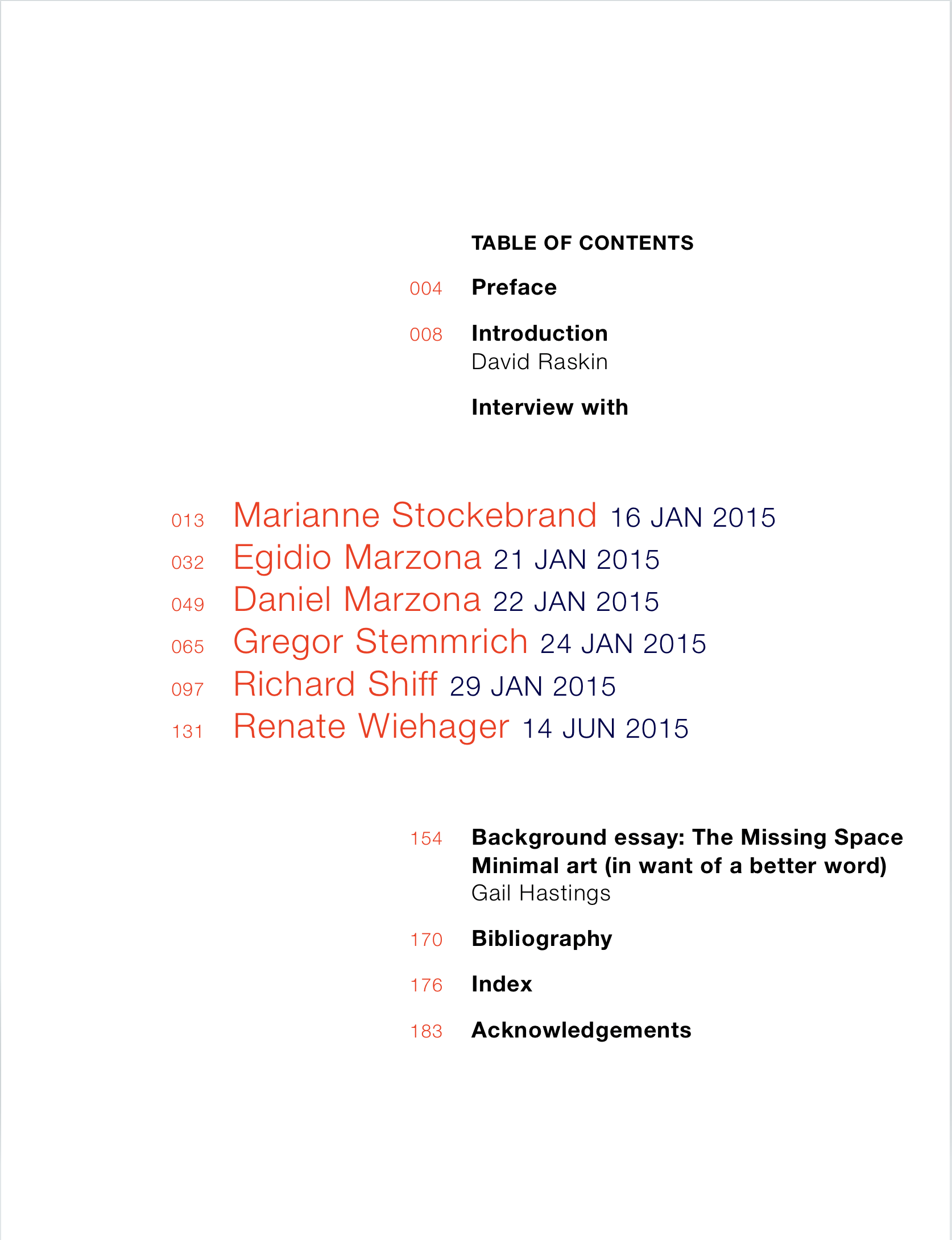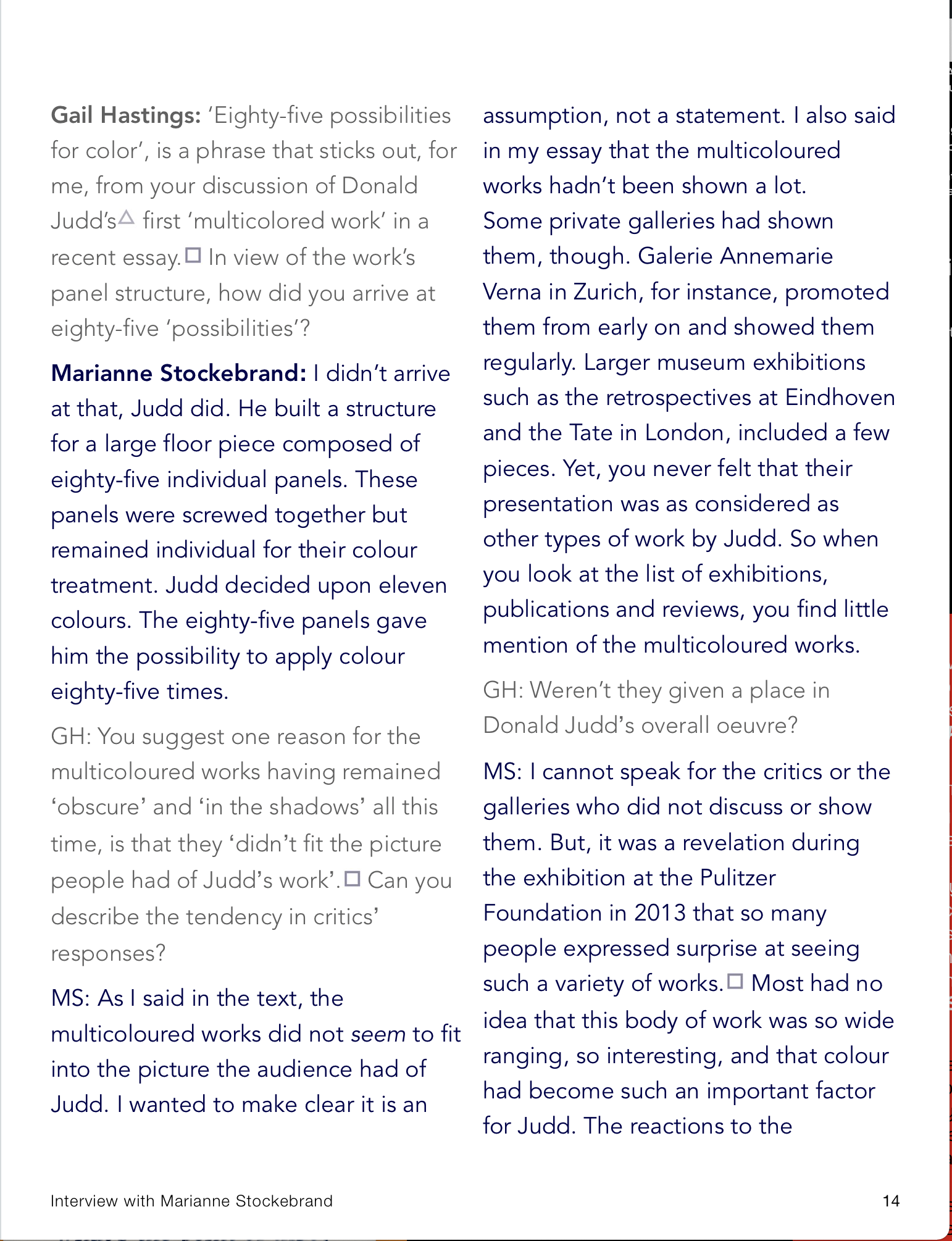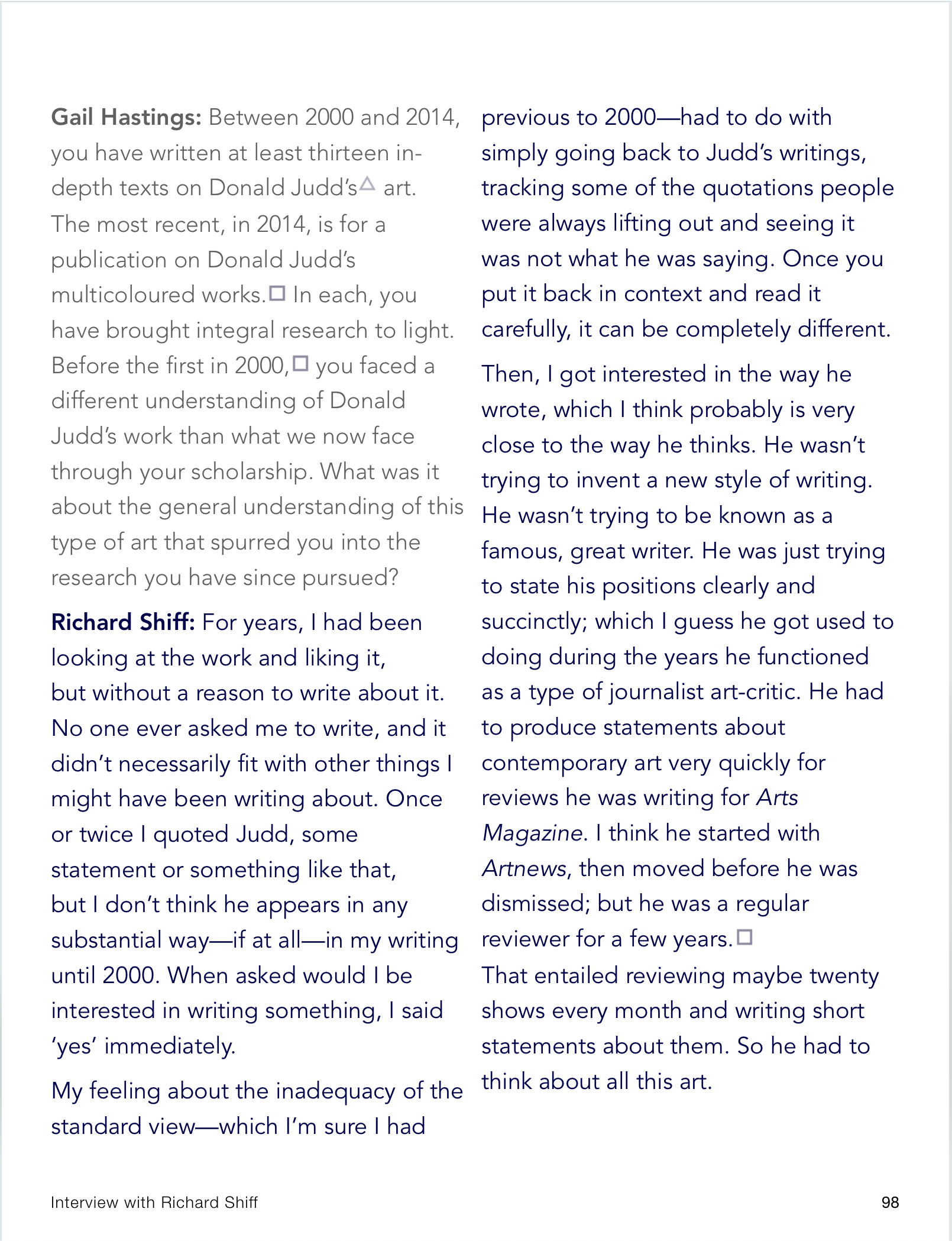The Missing Space Project: Six Interviews
Marianne Stockebrand
Egidio Marzona
Daniel Marzona
Gregor Stemmrich
Richard Shiff
Renate Wiehager
by Gail Hastings
Introduction by David Raskin
$14.99 AUD (incl GST)




For readers new to Minimal art, this volume is a good introduction to historical practices and changing understandings.
—— David Raskin, Introduction
INTERVEW EXCERPTS
I would say my training in Germany wasn’t special but rather typical. I studied art history, then worked in museums. Engaging with art is something one has to learn. I find it hard work, still today. It isn’t easy for me to write. I try to be as clear and as specific as I can, which I had to learn — I had to learn to look. That’s first.
—— Marianne Stockebrand
At the first art market exhibition in Köln there were, I think, just sixteen galleries. There were also some collectors, mostly from Belgium, and some visitors. It was very small; it was like a family party. There wasn’t much discussion, but it was very revolutionary. That was exhilarating. It upset my family to see me buy this type of art, they thought I was crazy.
—— Egidio Marzona
If you enter the issue of space, you enter certain problems. It would mean you would have to go back in time — philosophically and art historically — to discuss the treatment of space before. I couldn’t do that in my book, it was not that type of publication. It was basically Minimal art for beginners […] We are still waiting for this book to be written as it is certainly an issue.
—— Daniel Marzona
If you say the space is solid, it makes more sense to me. This happens with a Donald Judd. He makes his space solid, where proportion is very important. Proportion means space is a plastic medium in a certain way, but in a very specific way. It is not architectural, he is not an architect, but he is very much thinking and talking about proportions.
—— Gregor Stemmrich
If there is one thing Donald Judd repeats, it is don’t generalise. Don’t say that things are the same, because they are not. […] Don’t say that Newman is Pollock, or Pollock is Newman. They are doing different things. Minimalism — what would I read? I would be reading an article and it would be saying Robert Morris and Donald Judd are doing the same thing: uh-uh — hardly. […] The object has space. It is not phenomenological.
—— Richard Shiff
The thesis of our exhibition series was that there is a history of impact to be discovered that starts with the ‘emigration’ of European Bauhaus and Constructivism in the 1930s, their reception in the US and their continuation in contemporary art. From my point of view then, in 2001, I could see that Minimal art — the historical movement — was and is linked with a small number of artists who worked on a new definition of art as it relates to the space and to viewers.
—— Renate Wiehager
The Missing Space Project aims to redress a lapse in recognising differentiated space in art. Three-dimensional work, otherwise called Minimal art, introduced ‘actual space’ in the early 1960s. Yet, instead of an art-historical pronouncement of this new type of space in art, a jackhammer repetition of the word ‘reduction’ has defined it since. Still, today, texts stutter ‘reduction’ in a phase-locked loop begging for release to hear the words it has made silent these past fifty years, a latent lexicon that articulates art’s differentiated space.
Still, before this project can proceed, there is first the question: Would a project of this nature enrich a better understanding or create another stutter? To find out, the author conducted six face-to-face (except the last) interviews.
An eponymous exhibition catalogue, Minimalism in Germany: The Sixties (Hatje Cantz, 2012), offered contemporary agency for the interviews. Reduction as a process or description of the work resounds throughout the catalogue as Minimalism’s main characteristic. One way to escape the current disavowal of space would be to recognise Minimalism’s ownership of the term ‘reduction’ as separate from the historical works that we otherwise call Minimal art. Three-dimensional work that builds material space, could, then, redefine itself as something separate. It could pronounce the characteristics it has — its differentiated space — instead of being named for what it does not have, a reduction.
Did the interviews reach a conclusion? Not in chorus, but yes, as a loud disquiet. They reveal a need for further work to pry art history’s finger from the ‘reduction’ stuck button. A chasm would open amidst the generalised descriptions that would then compel us to find the words with which to describe a self-differentiating space that began in New York in the 1960s.
| Table of Contents | |
| Preface | 4 |
| Introduction by David Raskin | 8 |
| Marianne Stockebrand 16 JAN 2015 | 13 |
| Egidio Marzona 21 JAN 2015 | 32 |
| Daniel Marzona 22 JAN 2015 | 49 |
| Gregor Stemmrich 24 JAN 2015 | 65 |
| Richard Shiff 29 JAN 2015 | 97 |
| Renate Wiehager 14 JAN 2015 | 131 |
| Background essay by Gail Hastings | 154 |
| Bibliography | 170 |
| Index | 176 |
Preceding image: Extract from David Raskin, ‘Introduction’, The Missing Space Project: Six Interviews, Pigment Publisher, Sydney, 2015, pp. 8-12.
Click HERE to download the complete Introduction.
CONTRIBUTORS
MARIANNE STOCKEBRAND, art historian and curator, was the founding Director of the Chinati Foundation, Marfa, Texas, in 1994 after Donald Judd’s decease. In 2010 she returned to Europe to resettle in Berlin where this interview was conducted. Prior to Marfa, she was Director of Kölnischer Kunstverein, Cologne and, earlier still, Director of Westfälischer Kunstverien, Münster. Her many writings on Donald Judd are included in key catalogues of his work. In 2014 she was the instigator, editor and a contributor to a collection of essays in Donald Judd: The Multicolored Works referred to in the interview.
EGIDIO MARZONA began to collect art in the 1960s and has, for decades, remained faithful to work by Sol LeWitt, Donald Judd, Bruce Nauman and Carl Andre in addition to works by European artists. At the time of these interviews, a part of his collection was on show at the Hamburger Bahnhof, Museum für Gegenwart, Berlin, in the exhibition ’A-Z: The Marzona Collection‘. The Marzona Foundation has more recently transformed a former 1902 workshop by the architect Paul Schultze-Naumburg that was once a bastion for National Socialist ideology and Nazi propoganda, into a free academy for the experimental liberation of thought, creation, and discourse — the Design Academy Saaleck, dieDAS.
DANIEL MARZONA is Director of the Daniel Marzona contemporary art gallery in Berlin. He is the author of Minimal Art (2006) by Taschen, at which time he was also a freelance author and curator in Berlin and New York. He studied art history and philosophy at the Ruhr-University Bochum and from 2001 to 2003 he worked as Associate Curator at the P.S. 1 Contemporary Art Centre in New York.
GREGOR STEMMRICH is Professor of Art and Art History at the New York University Abu Dhabi. At the time of this interview he was Professor of modern and contemporary art at the Free University in Berlin (2007-2015). He studied art at the Düsseldorf Art Academy, and art history and philosophy at the Ruhr-University Bochum and University of Essen. He is the author of Minimal Art: Eine kritische Retrospektive (1995), amongst many other book on artists.
RICHARD SHIFF is the Effie Marie Cain Regents Chair in Art at The University of Texas at Austin, where he directs the Centre for the Study of Modernism. He is the recent author of Sensuous Thoughts: Essays on the Work of Donald Judd (2020), yet more widely know for Cézanne and the End of Impressionism (1984), Critical Terms for Art History (co edited, 1996, 2003), and Between Sense and De Kooning (2011).
RENATE WIEHAGER, PhD, is Head of the Daimler Art Collection in Berlin and Stuttgart since 2003 and, prior, Director of the Museum Villa Merkel in Esslingen. She studied art history, theology, literature and philosophy and was awarded a doctorate of philosophy in 1991 with a monograph on the German surrealist Richard Oelze (1900-1980). She is the curator of Minimalism in Germany: The Sixties, 2012, as part of an ongoing curatorial concern that updates, challenges and enriches a contemporary appreciation of minimalism. She has contributed over 300 articles to art journals and authored over 200 curatorial essays in exhibition catalogues.
DAVID RASKIN is the Mohn Family Professor of Contemporary Art History at the School of the Art Institute of Chicago and Chair of the Department of Sculpture. He has been awarded fellowships from the Smithsonian Institution, the National Endowment for the Humanities, the Wyeth Foundation for American Art, the American Council of Learned Societies, and the Whitney Museum. He is the author of numerous books on contemporary art including Donald Judd (hardcover 2010, paperback 2017).
GAIL HASTINGS is a visual artist.
